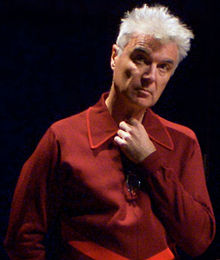[contextly_auto_sidebar id=”3o2cCBB8Yl5GOjG7dvH1Nruy0D97g8pq”]
THE ravages of the one percent — and what their surge has done to culture — is one of my abiding concerns on the blog. Now the Talking Heads frontman, who’s been quite outspoken lately on the politics of culture, weighs in on what the plutocracy has done to visual art. A New York Times post looks at his complaint as well as the context around it.
“I used to be able to convince myself that contemporary art was some kind of forum for ideas and feelings about the world we live in,” Mr. Byrne writes. “But hang on! It is! Those ideas and feelings are now about money and sucking up to those that have it and will part with a little bit of it. That is the world we live in! The work is indeed a commentary on our world, but the work is part of that swirl of luxury as well.”
For him, the economics now affect how he sees the work. “I have begun to view the work itself as being either intentionally or unconsciously produced expressly to cater to the 1%,” he writes, adding: “I can’t see the work or any ideas behind most of it anymore — if there even are any. The ideas might be there. The artists might be holding on to their integrity and be maintaining their distance from the dirty business of buying and selling, but I can no longer see it.
The post gets into Jerry Saltz’s complaints about artist Jeff Koons, and the larger issue of how we assess aesthetic things these days.
But with Mr. Koons, art fairs and auction houses, it’s often more about the metrics than the art. And the metrics used for measuring success, both in price and location, in the art world bother Edward Winkleman, writing at his blog: “The overarching trend here is to lazily borrow metrics from other asset markets or entertainment channels, even though most everyone will argue that true importance and quality in art transcend mere market concerns or popularity.”
Like the rest of the Op-Talk pieces, this post doesn’t take sides or solve the issue, but touches down on some important points that swirl around art, money, and the new Gilded Age.
UPDATE: Here’s a paragraph from Byrne’s original post:
It’s sad—I used to be able to convince myself that contemporary art was some kind of forum for ideas and feelings about the world we live in. But hang on! It is! Those ideas and feelings are now about money and sucking up to those that have it and will part with a little bit of it. That is the world we live in! The work is indeed a commentary on our world, but the work is part of that swirl of luxury as well. The intention of the artist might be ironic, but when their creations mimic the things and the world being criticized so perfectly, then the irony gets lost. A skull made of diamonds might be a comment on the over-the-top luxury mode of the art world, but it is more definitely of that world as well. The irony is sort of lost, if it was ever there. Now abstract art can safely be said to be about nothing but how big it is, where it can be placed and how much it costs.
Sigh. His points about irony especially resonant.


This is nothing new, unfortunately. After all, look at the way Mozart was treated in his lifetime. Now there are monuments to him everywhere, especially in Salzburg. But nobody say exactly where he’s buried, because he’s buried in a pauper’s grave.
If his artistic intellect, talent and courage were not valued appropriately enough to protect him from poverty, what real hope can any of the rest of us have?
I respectfully disagree with Mr. Byrne . Look at ArtPrize in Grand Rapids.
I love that the ArtPrize is funded (not sure how significantly) by the heirs of the Amway corporation. It really does seem like a well intentioned show with a balance of inside/outside voices, and I think it shows us we can’t ever really tell what will happen twenty years into the future.
I would agree with David Byrne that it is almost impossible to divorce issues of class from art and there is a lot of shilling for friends that masquerades as serious inquiry (I just got the alumni mailing from my graduate alma mater Virginia Commonwealth University and told my wife this morning that it could just as easily have been titled “look what YOU’RE not doing”), but also at the same time, as Dan says, it’s been this way for a long time. So are you altering your art practice to reflect this? Should you? Great questions all, and thanks to David Byrne for using his fame to talk about the bare butt of the emperor.